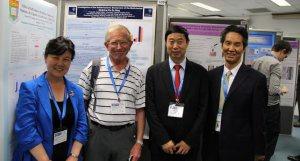PLoS ONE:首次发现专性传粉昆虫能分解孢粉素
孢粉素(sporonpollenin)是孢子和花粉外壁的主要成分,主要由脂肪酸及碳水化合物构成,但是其准确的结构仍然不清楚。孢粉素的性质坚固,能抗化学及生物分解,同时也不溶于无机和有机溶剂。孢粉素的这种特性是孢粉化石能保存上百万年的主要原因。虽然许多昆虫取食花粉表面的脂类或通过花粉萌发孔获得花粉内的营养成分,但是到目前为止没有任何动物能破坏孢粉壁。
中科院华南植物园系统与进化生物学研究领域张奠湘研究组的罗世孝博士等对叶下珠科的越南叶下珠(Phyllanthus cochinchinensis)和水油甘(P. rheopyticus)开展传粉生态学研究发现,两种未被描述的角麦蛾(Deltophora) sp.1和sp.2分别是越南叶下珠和水油甘的唯一传粉昆虫。两种叶下珠属植物与传粉角麦蛾之间形成了两对专性互利传粉关系。角麦蛾在访问植物雄花时吸取花蜜及收集花粉,在访问雌花时会为植物完成传粉。角麦蛾成虫以寄主植物的花蜜和花粉为食,并产卵于寄主植物上,其幼虫以取食寄主植物嫩叶为发育营养,而寄主植物依赖其唯一的传粉昆虫来完成传粉,传粉者与寄主植物间形成了一对一互利共生关系。
对角麦蛾研究最令人惊奇的发现是,角麦蛾口器分泌的一种分泌物能分解孢粉素和融解花粉。这是首次发现有昆虫(甚至可以说动物)能分解孢粉素和融解花粉。同时还发现,传粉昆虫角麦蛾不但具有特殊的访花行为,而且具有独特的口器结构。角麦蛾特殊的访花行为和独特的昆虫口器结构,为专性互利共生物种间往往演化出独特的行为与特殊的适应结构又提供了一个新的案例。
这一新的发现刚刚在线发表在科学杂志PLoS ONE上。这是继罗世孝博士及其合作者在2010年发现基部被子植物“八角属植物与传粉瘿蚊协同进化(Luo et al. 2010, Am. J. Bot. 97: 1220-1228)”后在植物与传粉昆虫协同进化研究方面的又一重要发现。
原文出处:
PLoS ONE 6(4): e19219. doi:10.1371/journal.pone.0019219
Gelechiidae Moths Are Capable of Chemically Dissolving the Pollen of Their Host Plants: First Documented Sporopollenin Breakdown by an Animal
Shixiao Luo1, Yongquan Li1, Shi Chen1, Dianxiang Zhang1*, Susanne S. Renner2*
1 Key Laboratory of Plant Resource Conservation and Sustainable Utilization, South China Botanical Garden, The Chinese Academy of Sciences, Guangzhou, China, 2 Department of Biology, University of Munich (LMU), Munich, Germany
Abstract
Background
Many insects feed on pollen surface lipids and contents accessible through the germination pores. Pollen walls, however, are not broken down because they consist of sporopollenin and are highly resistant to physical and enzymatic damage. Here we report that certain Microlepidoptera chemically dissolve pollen grains with exudates from their mouthparts.
Methodology/Principal Findings
Field observations and experiments in tropical China revealed that two species of Deltophora (Gelechioidea) are the exclusive pollinators of two species of Phyllanthus (Phyllanthaceae) on which their larvae develop and from which the **s take pollen and nectar. DNA sequences placed the moths and plants phylogenetically and confirmed that larvae were those of the pollinating moths; molecular clock dating suggests that the moth clade is younger than the plant clade. Captive moths with pollen on their mouthparts after 2-3 days of starvation no longer carried intact grains, and SEM photographs showed exine fragments on their proboscises. GC-MS revealed cis-β-ocimene as the dominant volatile in leaves and flowers, but GC-MS **yses of proboscis extracts failed to reveal an obvious sporopollenin-dissolving compound. A candidate is ethanolamine, which occurs in insect hemolymphs and is used to dissolve sporopollenin by palynologists.
Conclusions/Significance
This is the first report of any insect and indeed any animal chemically dissolving pollen.
A角麦蛾访雄花;B角麦蛾访雌花;C角麦蛾幼虫取食寄主嫩叶;D角麦蛾口器上携带寄主植物花粉;E角麦蛾独特口器上完整的花粉和分解的花粉块。
本站所注明来源为"爱爱医"的文章,版权归作者与本站共同所有,非经授权不得转载。
本站所有转载文章系出于传递更多信息之目的,且明确注明来源和作者,不希望被转载的媒体或个人可与我们
联系zlzs@120.net,我们将立即进行删除处理
热点图文
-
牛津大学:心速宁胶囊作用机制研究成果发表
2015年5月19日,由澳大利亚药理学会和英国药理学会主办的澳-英联合药理...[详细]
-
GM制药Epidiolex获FDA孤儿药资格
2月28日,GW制药宣布美国FDA授予该公司用于治疗儿童Lennox-Ga...[详细]


